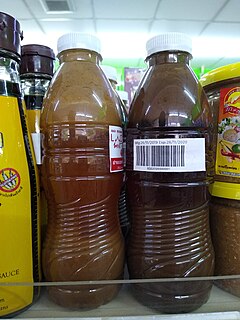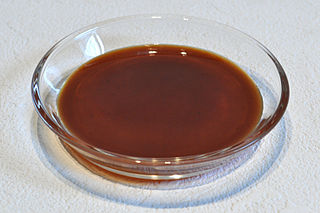 W
WFish sauce is a liquid condiment made from fish or krill that have been coated in salt and fermented for up to two years. It is widely used as a staple seasoning in East and Southeast Asian cuisine.
 W
WFish sauce is an amber-colored liquid extracted from the fermentation of fish with sea salt. It is used as a condiment in various cuisines. Fish sauce is a staple ingredient in numerous cultures in Southeast Asia and the coastal regions of East Asia, and features heavily in Cambodian, Filipino, Thai, and Vietnamese cuisine.
 W
WBagna càuda is a hot dish made from garlic and anchovies, originating in Piedmont, Italy during the 16th century. The dish is served and consumed in a manner similar to fondue, sometimes as an appetizer, with raw or cooked vegetables typically used to dip into it.
 W
WBagoóng is a Philippine condiment partially or completely made of either fermented fish (bagoóng) or krill or shrimp paste (alamáng) with salt. The fermentation process also produces fish sauce known as patís.
 W
WBagoong monamon, bagoong monamon-dilis, or simply bagoong and bugguong munamon in Ilocano, is a common ingredient used in the Philippines and particularly in Northern Ilocano cuisine. It is made by fermenting salted anchovies which is not designed, nor customarily used for immediate consumption since it is completely raw.
 W
WBagoong Terong or bagoong, and bugguong in the Ilocano language, is a common ingredient used in the Philippines and particularly in Northern Ilocano cuisine. It is made by salting and fermenting the bonnet mouth fish. This bagoong is coarser than Bagoong Monamon, and contains fragments of the salted and fermented fish ; they are similar in flavor. The odor is distinct and unique. Those who are unfamiliar with this condiment may find the smell repulsive. Bagoong is an essential ingredient in many curries and sauces. Fish sauce, common throughout Southeast Asian cuisine, is a by-product of the bagoong process. Known in the Philippines as patis, it is distinguished as the clear refined layer floating on the thicker bagoong. Patis and bagoong can be interchanged in recipes, depending on personal taste and preference.
 W
WBudu is an anchovies sauce and one of the best known fermented seafood products in Kelantan, Terengganu in Malaysia, southern Thailand and Natuna islands in Indonesia and South Sumatra, Bangka island and Western Kalimantan of Indonesia. It is mentioned in A Grammar and Dictionary of the Malay language, With a Preliminary Dissertation, Volume 2, By John Crawfurd, published in 1852.
 W
WCincalok is a Malay dish that originated in Malacca, Malaysia, consumed by Malay, Peranakan and Kristang. It can trace it origin during Portuguese occupation of Malacca. In Malacca, the shrimp is called udang geragau. This dish made up of fermented small shrimps or krill. It is usually served as a condiment together with chillis, shallots and lime juice. The shrimp in the pinkish coloured cincalok are readily identifiable and the taste is salty. Sir R. O. Winstedt has written about "Cencaluk" in Malaysia in his book "The Circumstances of Malay Life - 1909". This shrimp is available in particular season in Pantai Klebang, Limbongan, Tanjung Kling and several coastal areas.
 W
WColatura di alici is an Italian fish sauce made from anchovies, from the small fishing village of Cetara, Campania. The sauce is a transparent, amber-colored liquid, produced by fermenting anchovies in brine. The fish used in the sauce are harvested from the Amalfi Coast between March 25 (Annunciation) and July 22.
 W
WGarum was a fermented fish sauce used as a condiment in the cuisines of Phoenicia, ancient Greece, Rome, Carthage and later Byzantium. Liquamen was a similar preparation, and at times they were synonymous. Although garum enjoyed its greatest popularity in the Western Mediterranean and the Roman world, it was earlier used by the Greeks.
 W
WGentleman's Relish is a type of anchovy paste. It is also known as Patum Peperium. It was created in 1828 by an Englishman named John Osborn. It has a strong, very salty and slightly fishy taste, and contains anchovies, butter, herbs and spices. Today, the secret recipe is withheld from all but one employee at Elsenham Quality Foods in Elsenham, England, the licensed manufacturer.
 W
WMahyawa or mehyawa is an Iranian cuisine tangy sauce made out of fermented fish.
 W
WNgapi, formerly also spelled ngapee, nga-pee, and gnapee, is a pungent paste made of either fish or shrimp in Burmese cuisine. Ngapi is usually made by fermenting fish or shrimp that is salted and ground then sun dried. Many variations exist as Ngapi applies only to the content. Like cheese, it can be distinguished based on main ingredient and regional origin. Ngapi can be distinguished from the type of fish used to make it. Ngapi can come from whole fish, from small fish or from prawns. Ngapi is a main ingredient of Lower Burmese cooking and is used as a condiment or additive in most dishes. Raw ngapi is not intended for direct consumption.
 W
WPadaek, sometimes known as padek, or Lao fish sauce or pla-ra in Thailand, is a traditional Lao condiment made from pickled or fermented fish that has been cured. It is thicker and more seasoned than the fish sauce more commonly seen throughout Thailand and Vietnam, often containing chunks of fish. The fermentation takes a long time, giving padaek an aroma similar to cheeses like Époisses.
 W
WPla ra, also called Padaek, (Lao:ປາແດກ) is a traditional Lao and Isan seasoning produced by fermenting fish with rice bran or roasted rice flour and salt fermented in a closed container for at least six months. Fermented fish seasoning are commonly found in Cambodian, Lao, Mon, Thai and Vietnamese cuisine. Pla ra has a very strong smell, which is considered unpleasant by some people. Its flavors are salty and sour, depending on the amount of salt put in and lactic acid resulting from fermentation process.
 W
WPrahok (ប្រហុក) is a crushed, salted and fermented fish paste that is used in Cambodian cuisine as a seasoning or a condiment. It originated as a way of preserving fish during the months when fresh fish was not available in abundant supply. Because of its saltiness and strong flavor, it was used as an addition to many meals in Cambodian cuisine, such as soups and sauces. A Cambodian saying goes, "No prahok, no salt", referring to a dish that is of poor flavor or bland thus highlighting its essentiality in Cambodian cuisine. Prahok has a strong and distinct smell, earning the nickname "Cambodian cheese" among food writers. Prahok is usually eaten as a main course with white rice and vegetable such as yardlong bean, cucumbers, and Thai eggplant.
 W
WShottsuru (塩魚汁) is a pungent regional Japanese fish sauce similar to the Thai nam pla. The authentic version is made from the fish known the hatahata, and its production is associated with the Akita region.
 W
WShrimp paste or prawn sauce is a fermented condiment commonly used in Southeast Asian and Southern Chinese cuisines. It is primarily made from finely crushed shrimp or krill mixed with salt, and then fermented for several weeks. They are either sold in their wet form or are sun-dried and either cut into rectangular blocks or sold in bulk. It is an essential ingredient in many curries, sauces and sambal. Shrimp paste can be found in many meals in Indonesia, Cambodia, Laos, Malaysia, Myanmar, the Philippines, Singapore, Thailand, and Vietnam. It is often an ingredient in dip for fish or vegetables.
 W
WWorcestershire sauce is a fermented liquid condiment created in the city of Worcester in Worcestershire, England during the first half of the 19th century. The creators were the chemists John Wheeley Lea and William Henry Perrins, who went on to form the company Lea & Perrins. Worcestershire sauce has been considered a generic term since 1876, when the English High Court of Justice ruled that Lea & Perrins did not own the trademark to "Worcestershire".
 W
WXO sauce is a spicy seafood sauce from Hong Kong with an umami flavor. It is commonly used in southern Chinese regions such as Guangdong.